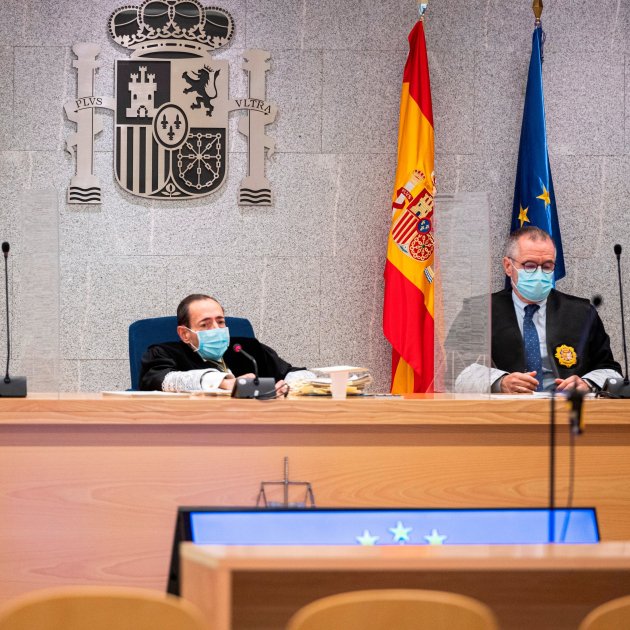The imam who led the Jihadi terrorist cell which carried out the August 2017 attacks on Barcelona and Cambrils was a "paranoid" person, constantly focused on maintaining control of the mosque.
As the trial of three men alleged to have taken part in the terror plan begins its fourth week in Spain's National Audience, the court has today heard from witnesses who testified about the character of the alleged terror cell leader, Abbelbaki Es-Satty, imam in the northern Catalonia town of Ripoll. Es-Satty, now thought to be dead, as almost all the other terrorists are, remains a mystery figure in the narrative of the attacks because of his known connections to Spanish police and intelligence, for whom he was an informer.
Cristian R., one of two men converted to Islam who were close to Es-Satty when he was imam at Castelló de la Plana in 2014, defined him as a "paranoid" figure. “For him any non-Muslim person deserved to die,” explained the witness, adding that on several occasions he said that carrying terrorist attacks in Spain would be justified. The second witness to testify this Monday was another convert, Adrián F., who received a visit from Es-Satty in the summer of 2017 before he travelled to Morocco for the last time before the attacks on August 17th. He explained that Es-Satty was the leader of the Ripoll cell "not because he was a manipulator but because he was the imam". He said he does not remember if the imam showed them videos or how he justified violence.
Witness describes Es-Satty: "For example, if he saw a non-Muslim out walking their dog on the street, for him that person might be the worst person in the world."
In 2014, after being released from prison after serving a sentence for drug-trafficking, Abbelbaki Es-Satty was an imam in Castelló de Plana, in the Valencia Country, where he indoctrinated two young men who testified at the trial of Mohamed Houli Chemlal, Driss Oukabir, and Said Ben Iazza.
Adrián F., who went to the Civil Guard after the attacks, explained that he began to trust Es-Satty because the imam repaired his computer and he listened to the older man because he thought that "being a person who had memorized the Koran, he would be knowledgeable". Es-Satty indoctrinated him by defending jihadist attacks and showing him propaganda videos of the Islamic State organization.
Little by little he became "disillusioned" and "turned away" from his teachings. The imam defended carrying out attacks in Spain. He told Adrián that he had shared a flat with a man who had gone to Iraq to commit an attack "killing a lot of people with a truck," that he wanted to create a base by tunneling into a mountain with an excavator or that they could go into a supermarket "and flatten everything". "It seemed fine to the imam, he explained this with pride," he said, referring to the possibility of committing attacks.
Cristian R. said that these approaches did not seem good to him and that is why he distanced himself from them and when the imam left Castelló he said that they lost contact. He did not go to the police about what he heard because he thought it was “impossible” and did not see the imam capable of putting it into practice. "If it weren't for that, I would have reported it for sure," he said.
According to Cristian R., whenever they went to Es-Satty's house he was together with Adrián F. In response to most of the questions asked Cristian R. said he didn't remember what had happened. He did not remember seeing videos, how he met the imam, whether they talked about the jihad, whether he had backed the idea of committing violent actions or what they talked about.
Unlike the other witness, Adrián F. said he did maintain a close relationship with Es-Satty after he left Castelló, both by telephone and in person. For example, he explained that the imam visited him in July 2017 before leaving for Morocco. And that three months before the attack, three members of the terror cell, Younes Abouyaaqoub, Yousseff Aalla and Mohamed Hichamy visited him to give him money as charity.
Adrián F. said that they were "friends" and when he saw on television that the Alcanar house the group had rented has suffered an explosion, he phoned both the imam and Youssef Aalla to find out how they were - calls that went unanswered, as both men are thought to have died while preparing explosives at the house. Adrián F. said that on several occasions he went to the house at Alcanar, where he said he saw no explosives.
It was the explosion at Alcanar on August 16th 2017, killing the imam and one other member of the group, which put paid to the plan for an attack with explosives on a tourist site - possibly Camp Nou stadium or the Sagrada Família temple. Instead, on August 17th they improvised the deadly van attack on Barcelona's Rambla and a rampage in a car and knife attacks in the coastal town of Cambrils.
